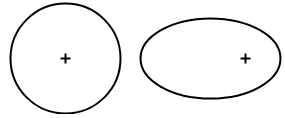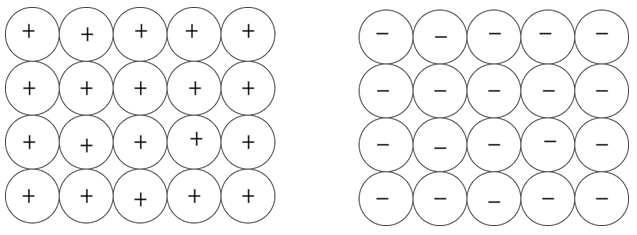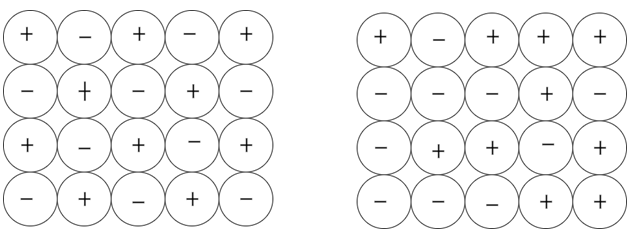This set of Engineering Materials & Metallurgy Multiple Choice Questions & Answers (MCQs) focuses on “Polarisation and Dielectrics”.
1. What is the value of dielectric constant of free space?
a) 8.854 * 10-9 F m-1
b) 8.854 * 10-12 F -1
c) 8.854 * 10-15 F -1
d) 8.854 * 10-6 F -1
View Answer
Explanation: The dielectric constant is that value which designates the capacity of a material to store electrical energy. It is denoted by and has a value of 8.854 * 10-12 F m-1. Dielectric constant is denoted as Farad per meter.
2. What is the unit of polarization?
a) Cm
b) Vm-1
c) Cm-2
d) Fm2
View Answer
Explanation: The unit of Polarization (P) and the Saturation Polarization (Ps) is given as coulomb per square meter (Cm-2). Coulomb meter (Cm) is used to denote the dipole moment, whereas farad meter square (Fm2) is used to denote electronic polarizability.
3. How is the dielectric strength denoted as?
a) s-1
b) Vm-1
c) Fm2
d) CV-1
View Answer
Explanation: The dielectric strength of a material is defined as the maximum amount of electric field that it can withstand without a fracture. It is denoted as volt per meter (Vm-1) or newton per coulomb (NC-1). Dielectric strength can alternatively be referred to as electric field strength (E).
4. What is the charge of an electron?
a) 1.602 * 10-16
b) 1.602 * 10-17
c) 1.602 * 10-18
d) 1.602 * 10-19
View Answer
Explanation: An electron is a negatively charged subatomic particle having a mass of 9.1 * 10-31. It has an electronic charge of 1.602 * 10-19 C which is denoted by e or e-.
5. Which of the following factors are relevant for change in dielectric strength?
a) Decreases with a decrease in thickness
b) Decreases with a decrease in temperature
c) Decreases with an increase in humidity
d) Decreases with a decrease in frequency
View Answer
Explanation: Dielectric strength is defined as the minimum applied voltage that would result in a fracture. The dielectric strength decreases with increase in thickness of the sample, operating temperature, and the frequency. Increased humidity decreases the dielectric strength in case of gases and air.
6. What is the dielectric constant of free space?
a) ![]()
b) ![]()
c) ![]()
d) 
View Answer
Explanation: The dielectric constant is that value which denotes the capacity of a material to store electrical energy. It is denoted by
 . It has a constant value of 8.854 * 10-12 Fm-1.
. It has a constant value of 8.854 * 10-12 Fm-1.7. What is the electric polarizability of helium?
a) 0.18 * 10-40 Fm2
b) 0.35 * 10-40 Fm2
c) 1.43 * 10-40 Fm2
d) 3.54 * 10-40 Fm2
View Answer
Explanation: The constant of proportionality of electric dipole moment is defined as electric polarizability. The polarizability increases with increasing volume of the atom. The electric polarizability of helium is 0.18 * 10-40 Fm2 and has the value of 0.35 * 10-40, Fm2 1.43 * 10-40 Fm2, and 3.54 * 10-40 Fm2 for neon, argon, and xenon in that order.
8. Which polarization process does this figure represent?

a) Ionic
b) Electronic
c) Orientation
d) Space charge
View Answer
Explanation: Atoms require an excess charge (either positive or negative) during chemical bonding. When an electric field is passed for this, the cations and anions may get displaced. The displacement for this electronic polarization is illustrated in the figure.
9. Which if the following shows space charge polarization?
a) 
b) 
c) 
d) 
View Answer
Explanation: In some instances, the materials begin to accumulate the charges at the electrode or interface. The diffusion of ions occurs over a distance, which causes a rearrangement or the dielectric medium. Such a reorganization is seen as the space charge polarization.
10. Polarization occurring due to magnetic moment is known as ______
a) Ionic
b) Electronic
c) Orientation
d) Space charge
View Answer
Explanation: When an electric field is applied to molecules having a dipole moment, they tend to rearrange themselves. This is due to the effect of applied magnetic field, which gives rise to paramagnetism.
11. What is the dielectric strength of mica?
a) 10 * 106 Vm-1
b) 100 * 106 Vm-1
c) 25 * 106 Vm-1
d) 15 * 106 Vm-1
View Answer
Explanation: Dielectric strength is defined as the least amount of applied voltage that would result in a rupture. Mica is an important dielectric material having a dielectric strength of 100 * 106 Vm-1 and a dielectric constant of 8 at 60 Hz. The dielectric strength of fused silica, vulcanized rubber, and Bakelite are 10 * 106 Vm-1, 25 * 106 Vm-1, and 15 * 106 Vm-1 correspondingly.
12. What is the dielectric constant of Nylon 6, 6 at 60 Hz?
a) 3.5
b) 4
c) 7
d) 8
View Answer
Explanation: The dielectric constant is that value which denotes the ability of a material to accumulate electrical energy. Nylon 6, 6 is an important dielectric material having a dielectric strength of 15 * 106 Vm-1 and a dielectric constant of 8 at 60 Hz, or 3.5 at 106 Hz. The dielectric constants of plasticized polyvinyl chloride and mica are 7 and 8 respectively.
13. The electrical response of a crystal is known as _______
a) Dielectric strength
b) Dielectric constant
c) Piezoelectric effect
d) Hysteresis
View Answer
Explanation: The mechanical response of a ferroelectric crystal on the application of an electric field is known as the piezoelectric effect. The piezoelectric effect can be seen in ferroelectric crystals. BaTiO3 is a common ferroelectric crystal, which is used for its piezoelectric properties in microphones, strain gauges, and sonar devices.
Sanfoundry Global Education & Learning Series – Engineering Materials & Metallurgy.
To practice all areas of Engineering Materials & Metallurgy, here is complete set of 1000+ Multiple Choice Questions and Answers.
If you find a mistake in question / option / answer, kindly take a screenshot and email to [email protected]
- Practice Metallurgical Engineering MCQs
- Check Engineering Materials Books
- Check Metallurgical Engineering Books
- Apply for Metallurgical Engineering Internship
